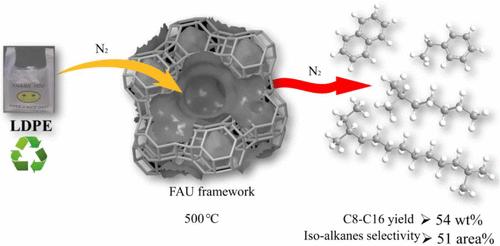y型沸石催化热解低密度聚乙烯一步法生产富异烷烃可持续航空燃料馏分
IF 7.3
1区 化学
Q1 CHEMISTRY, MULTIDISCIPLINARY
引用次数: 0
摘要
本研究介绍了一种生产富异烷烃可持续航空燃料(SAF)馏分的创新方法。它涉及使用y型沸石作为催化剂催化热解低密度聚乙烯(LDPE),无需外部氢气供应,所有这些都可以在固定床反应器中在常压下一步完成。对HY、HUSY、Meso-HY等Y型分子筛催化剂进行了比较,并对原料催化剂比和热解温度对产率和燃料组成的影响进行了评价。在500℃条件下,原料与催化剂质量比为3:2的Meso-HY催化剂的最佳条件下,SAF组分的最佳选择性为78%,SAF组分的收率为54.13 wt %。所得液体燃料对异烷烃具有较高的选择性(面积% 51),对芳烃具有较低的选择性(面积% 21.9)。介孔结构和弱酸性有利于异烷烃的生成,是催化剂性能优异的主要原因。此外,开发了一种具有磁性质的新型Fe/Meso-HY催化剂,有利于催化剂热解后的回收,稳定性好,对异构化效率的影响最小。通过实验与ReaxFF MD模拟相结合,探讨了热解过程中的氢转移;并提出了LDPE异构化过程中氢自供机理的反应途径。该研究结果为从废塑料中生产SAF提供了基本的理解,并为优化生产方法提供了有价值的见解。本文章由计算机程序翻译,如有差异,请以英文原文为准。

One-Step Production of Isoalkane-Rich Sustainable Aviation Fuel Fractions via Catalytic Pyrolysis of Low-Density Polyethylene over Y-Type Zeolite
This study introduces an innovative approach for producing isoalkane-enriched sustainable aviation fuel (SAF) fractions. It involves catalytic pyrolysis of low-density polyethylene (LDPE) using Y-type zeolites as catalysts without an external hydrogen supply, all of which can be conducted in one step under atmospheric pressure in a fixed-bed reactor. The Y zeolite catalysts, including HY, HUSY, and Meso-HY, are compared, and the influences of feedstock-to-catalyst ratio and pyrolysis temperatures on the yield and composition of the resulting fuels are evaluated. The optimal conditions are identified to use the Meso-HY catalyst with a feedstock-to-catalyst mass ratio of 3:2 at 500 °C, achieving an optimum SAF component selectivity of 78 area% and SAF fractions’ yield of 54.13 wt %. The resultant liquid fuel exhibits a high selectivity of isoalkanes (51 area%) and relatively low selectivity of aromatics (21.9 area%). The superior performance of the Meso-HY catalyst is attributed to its mesoporous structure and weak acidity, which favor the formation of isoalkanes. Additionally, a novel Fe/Meso-HY catalyst with magnetic properties has been developed to facilitate catalyst recovery after pyrolysis, showing good stability and minimal impact on isomerization efficiency. Hydrogen transfer during pyrolysis is explored by combining experiments and ReaxFF MD simulations; and a reaction pathway elucidating the mechanism of hydrogen self-supply during LDPE isomerization has also been proposed. The findings offer a foundational understanding required for producing SAF from waste plastics and provide valuable insights into the optimization of the production methods.
求助全文
通过发布文献求助,成功后即可免费获取论文全文。
去求助
来源期刊

ACS Sustainable Chemistry & Engineering
CHEMISTRY, MULTIDISCIPLINARY-ENGINEERING, CHEMICAL
CiteScore
13.80
自引率
4.80%
发文量
1470
审稿时长
1.7 months
期刊介绍:
ACS Sustainable Chemistry & Engineering is a prestigious weekly peer-reviewed scientific journal published by the American Chemical Society. Dedicated to advancing the principles of green chemistry and green engineering, it covers a wide array of research topics including green chemistry, green engineering, biomass, alternative energy, and life cycle assessment.
The journal welcomes submissions in various formats, including Letters, Articles, Features, and Perspectives (Reviews), that address the challenges of sustainability in the chemical enterprise and contribute to the advancement of sustainable practices. Join us in shaping the future of sustainable chemistry and engineering.
 求助内容:
求助内容: 应助结果提醒方式:
应助结果提醒方式:


